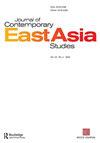Unpacking Sino-Central Asian engagement along the New Silk Road: a case study of Kazakhstan
IF 1.4
Q1 AREA STUDIES
引用次数: 37
Abstract
ABSTRACT Background. Although China’s Belt and Road Initiative (BRI) has received increasing attention at the global level, there is, however, little information about how and with what implications it is being enacted on the ground. This is partly because existing scholarship has primarily focused on Chinese interests and motives behind the grand proposal, while perspectives of other countries participating in the BRI remain understudied.Purpose. The study seeks to bridge this gap by contextualizing the land-based component of the BRI, Silk Road Economic Belt (SREB), in Central Asia. Its purpose is two-fold: (1) to discuss how Beijing perceives the role of Central Asia in general and Kazakhstan in particular in advancing its New Silk Road proposal; (2) to explore how the SREB is being implemented and perceived in Kazakhstan, where it was first announced in September 2013. In particular, it offers a detailed account of how Kazakhstan is trying to integrate its infrastructure development program “Nurly Zhol” for 2015-2019 into the SREB, which is missing from the current scholarly literature. Main Argument. The paper argues that, notwithstanding power asymmetries, the BRI participant/recipient countries do have the agency to develop their own agenda and relevant policies for interactions with Beijing. Conclusion. The case study analysis suggests that there is little evidence that China unilaterally imposes its agenda upon Kazakhstan. Moreover, a shared understanding between the two states about the complementarity of mutual interests provides a solid foundation for overall Kazakh-Chinese cooperation. Yet, the strengthening of relations between the two neighbors, especially in the economic domain, has not led to an improvement of Kazakh popular perceptions of China, whose image is further worsened by the ongoing securitization of ethnic minorities in Xinjiang, including Kazakhs.解读新丝绸之路沿线的中国-中亚交往:以哈萨克斯坦为例
摘要背景。尽管中国的“一带一路”倡议在全球范围内受到越来越多的关注,但关于该倡议在当地的实施方式和影响的信息却很少。这在一定程度上是因为现有的学术研究主要关注中国的利益和宏伟提案背后的动机,而参与“一带一路”倡议的其他国家的观点仍然研究不足。意图这项研究试图通过将“一带一路”倡议的陆上部分——中亚丝绸之路经济带(SREB)——置于背景中来弥合这一差距。其目的有两个:(1)讨论北京如何看待整个中亚,特别是哈萨克斯坦在推进其新丝绸之路提案中的作用;(2) 探讨2013年9月首次宣布的SREB在哈萨克斯坦的实施和看法。特别是,它详细介绍了哈萨克斯坦如何试图将其2015-2019年的基础设施发展计划“Nurly Zhol”纳入SREB,这是当前学术文献中缺失的。主要论点。该论文认为,尽管存在权力不对称,“一带一路”倡议的参与者/接受国确实有权制定自己的议程和相关政策,与北京进行互动。结论案例分析表明,几乎没有证据表明中国单方面将其议程强加给哈萨克斯坦。此外,两国对相互利益互补性的共同理解为哈中全面合作奠定了坚实基础。然而,这两个邻国之间关系的加强,特别是在经济领域,并没有导致哈萨克斯坦民众对中国的看法有所改善,包括哈萨克人在内的新疆少数民族的持续证券化使中国的形象进一步恶化。
本文章由计算机程序翻译,如有差异,请以英文原文为准。
求助全文
约1分钟内获得全文
求助全文
来源期刊

Journal of Contemporary East Asia Studies
Social Sciences-Cultural Studies
CiteScore
2.50
自引率
0.00%
发文量
10
审稿时长
6 weeks
 求助内容:
求助内容: 应助结果提醒方式:
应助结果提醒方式:


